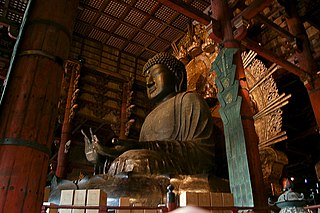 W
WThe Nara period of the history of Japan covers the years from AD 710 to 794. Empress Genmei established the capital of Heijō-kyō. Except for a five-year period (740–745), when the capital was briefly moved again, it remained the capital of Japanese civilization until Emperor Kanmu established a new capital, Nagaoka-kyō, in 784, before moving to Heian-kyō, modern Kyoto, a decade later in 794.
 W
WAkahogi Tile Kiln site is the remains of a late Nara period, early Heian period roof tile and pottery production site located in what is now the city of Takayama, Gifu Prefecture in the Chūbu region of Japan. It has been protected by the central government as a National Historic Site since 1976.
 W
WAkita Castle refers to the ruins of a Nara period fortified settlement located in what is now the city Akita, Akita Prefecture, Japan. It is also sometimes referred to as “Fort Akita”. The name is sometimes also used for Kubota Castle, an Edo period Japanese castle which served as the headquarters or the Satake, daimyō of Kubota Domain, rulers of northern Dewa Province under the Tokugawa shogunate.
 W
WThe Chōjagadaira Kanga ruins is an archaeological site with the ruins of a Nara to Heian period government administrative complex located in what is now on the border of the cities of Nasukarasuyama, and Sakura in Tochigi prefecture in the northern Kantō region of Japan. It is protected by the central government as a National Historic Site from 2009.
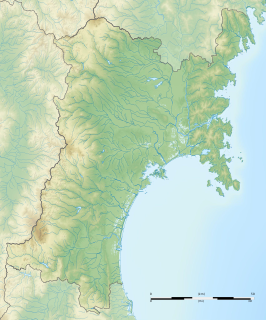 W
WThe Daikichiyama Tile Kiln ruin is an archaeological site with the remains of a late Nara period to early Heian period roof tile production site located in what is now the city of Ōsaki, Miyagi Prefecture in the Tōhoku region of northern Japan. It has been protected by the central government as a National Historic Site since 1976.
 W
WEnryaku-ji is a Tendai monastery located on Mount Hiei in Ōtsu, overlooking Kyoto. It was founded in 788 during the early Heian period (794–1185). The temple complex was established by Saichō (767–822), also known as Dengyō Daishi, who introduced the Tendai sect of Mahayana Buddhism to Japan from China. Enryaku-ji is the headquarters of the Tendai sect and one of the most significant monasteries in Japanese history. As such, it is part of the UNESCO World Heritage Site "Historic Monuments of Ancient Kyoto ". The founders of Jōdo-shū, Jōdo Shinshū, Sōtō Zen, and Nichiren Buddhism all spent time at the monastery. Enryaku-ji is also the center for the practice of kaihōgyō.
 W
WThe Fujiwara no Hirotsugu rebellion was an unsuccessful Nara period rebellion led by Fujiwara no Hirotsugu (藤原広嗣) in the Japanese islands, in the year 740. Hirotsugu, dissatisfied with the political powers, raised an army in Dazaifu, Kyushu but was defeated by government forces.
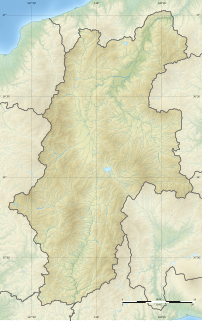 W
WThe Gonga Administrative Complex ruins is an archaeological site containing the ruins of the Nara to early Heian period government administrative complex for Ina District, Shinano Province, located in what is now part of the town of Iida, Nagano in the Chūbu region of Japan. The site was designated a National Historic Site of Japan in 2014.
 W
WHaji pottery is a type of plain, unglazed, reddish-brown Japanese pottery or earthenware that was produced during the Kofun, Nara, and Heian periods of Japanese history. It was used for both ritual and utilitarian purposes, and many examples have been found in Japanese tombs, where they form part of the basis of dating archaeological sites.
 W
WHeijō Palace was the imperial residence in the Japanese capital city Heijō-kyō, during most of the Nara period. The palace, which served as the imperial residence and the administrative centre of for most of the Nara period from 710 to 794 AD, was located at the north-central location of the city in accordance with the Chinese models used for the design of the capital.
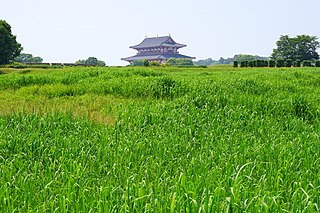 W
WHeijō-kyō , was the Capital of Japan during most of the Nara period, from 710–40 and again from 745–84. The imperial palace is a listed UNESCO World Heritage together with other places in the city of Nara.
 W
WHida Kokubun-ji (飛騨国分寺) is a Shingon-sect Buddhist temple in the city of Takayama, Gifu, Japan. It is one of the few surviving provincial temples established by Emperor Shōmu during the Nara period. Due to this connection, the foundation stones of the Nara period pagoda located on temple grounds were designated as a National Historic Site by the Japanese government in 1929.
 W
WThe Higashiyama Kanga ruins is an archaeological site with ruins of a Nara period to early Heian period government administrative complex located in what is now part of the town of Kami in Kami District, Miyagi prefecture in the Tōhoku region of far northern Honshu, Japan. The site was proclaimed a National National Historic Site in January 1999.The site was excavated in 1986. It is roughly contemporary with Taga Castle to the southeast.
 W
WHinodeyama Tile Kiln ruins is an archaeological site consisting of the remains of seven Nara period kilns located in what is now the town of Shikama, Miyagi Prefecture in the Tōhoku region of northern Japan. It has been protected by the central government as a National Historic Site since 1976.
 W
WHokke-ji , is a Buddhist temple in the city of Nara, Japan.
 W
WIji Castle was jōsaku-style Japanese castle built during late Nara period. Its ruins are now an archaeological site in the city of Kurihara, Miyagi prefecture in the Tōhoku region of northern Japan. The site has been protected as a National Historic Site on August 27, 2003.
 W
WIzu Kokubun-ji (伊豆国分寺) is a Buddhist temple located in what is now the city of Mishima, Shizuoka, Japan. It is the modern successor of one of the provincial temples established by Emperor Shōmu during the Nara period for the purpose of promoting Buddhism as the national religion of Japan and standardising control of Yamato rule over the provinces. The foundation stones for the seven-story pagoda of original temple was designated as a National Historic Site by the Japanese government in 1956.
 W
WThe Jō Palisade site is an archaeological site with the ruins of a Nara period jōsaku-style Japanese castle, located in what is now part of the town of Kami in Kami District, Miyagi prefecture in the Tōhoku region of far northern Honshu, Japan. The site was proclaimed a National National Historic Site in 1979. The actual name of this fortification remains unknown, and it has been postulated that it was one of the five fortifications, possibly the “Shikama-saku” or “Takazukuri-saku”, mentioned in historical records, as having even constructed in 737 AD, although evidence is scant. It is roughly contemporary with the much larger Taga Castle to the southeast.
 W
WKai Kokubun-ji (甲斐国分寺) is a Rinzai Zen Buddhist temple located in the city of Fuefuki, Yamanashi, Japan. It is the descendant of one of the provincial temples established by Emperor Shōmu during the Nara period for the purpose of promoting Buddhism as the national religion of Japan and standardising control of the Yamato rule to the provinces. The ruins of the Nara period temple are adjacent to the modern temple and were designated as a National Historic Site by the Japanese government in 1922.
 W
WThe Kamikōnushi・Mobara kanga ruins is an archaeological site with the ruins of a Nara to Heian period government administrative complex located in what is now on the border of the town of Kaminokawa, with the city of Utsunomiya in Tochigi prefecture in the northern Kantō region of Japan. It has been protected as a National Historic Site from 2003. The Kita-Kantō Expressway cuts directly across the site.
 W
WThe Kamo Site is an archaeological site in what is now the town of Tsubata, Ishikawa in the Hokuriku region of Japan. The site was designated a National Historic Site of Japan in 2015.
 W
WThe Kanaizawa Stele is a Nara period stele discovered in the Yamana neighborhood of the city of Takasaki, Gunma Prefecture, in the northern Kantō region of Japan. The stele was designated a National Historic Site of Japan in 1921, and was raised in status to a Special National Historic Site in 1954. As one of the "Three Stelae of Kōzuke", it was submitted by Japan for inclusion into the UNESCO Memory of the World Programme in 2017
 W
WKasuga Grand Shrine is a Shinto shrine in Nara, Nara Prefecture, Japan. It is the shrine of the Fujiwara family, established in 768 CE and rebuilt several times over the centuries. The interior is famous for its many bronze lanterns, as well as the many stone lanterns that lead up the shrine.
 W
WKajiyama temple ruins is an archaeological site with the ruins of a Nara period Buddhist temple located in what is now Aoi-ku of the city of Shizuoka, Japan. The temple no longer exists, but the temple grounds were designated as a National Historic Site by the Japanese government in 1965.
 W
WKido Tile Kiln site is an archaeological site with the remains of a late Nara period, early Heian period kiln for roof tile production located in what is now the city of Ōsaki, Miyagi Prefecture in the Tōhoku region of northern Japan. It has been protected by the central government as a National Historic Site since 1976.
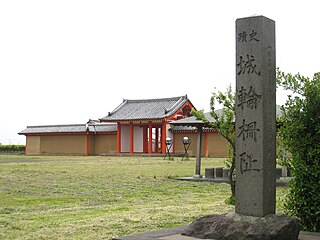 W
WKiwanosaku was a late Nara period though Heian period josaku-style Japanese castle located in what is now part of the town of Sakata, Yamagata Prefecture in the Tōhoku region of Japan. Its ruins are now an archaeological site and have been protected by the central government as a National Historic Site since 1932.
 W
WKofun are megalithic tombs or tumuli in Japan, constructed between the early 3rd century and the early 7th century AD. The term is the origin of the name of the Kofun period, which indicates the middle 3rd century to early–middle 6th century. Many Kofun have distinctive keyhole-shaped mounds, which are unique to ancient Japan. The Mozu-Furuichi kofungun or tumulus clusters were inscribed on the UNESCO World Heritage List in 2019, while Ishibutai Kofun is one of a number in Asuka-Fujiwara residing on the Tentative List.
 W
WThe Koganeyama Jinja (黄金山神社) is a Shintō shrine in the town of Wakuya Tōda District, Miyagi Prefecture in the Tōhoku region of northern Japan. It claims to have been built on the site of the first gold mine in Japan, and is protected by the central government as a National Historic Site.
 W
WOver the course of the Yamato period, in the early centuries of the establishment of a Japanese state, a great number of Korean-style fortresses were constructed in Japan. Old fortresses dating to the 8th century and earlier can be found all over western Japan. Many of these sites have been identified with fortresses whose construction, repair, and destruction are described in detail in ancient chronicles such as Nihon Shoki and Shoku Nihongi. According to some interpretations of these texts, these fortresses were built under the guidance of, and at the orders of, various members of the Korean nobility or royalty.
 W
WKuni-kyō, was the capital city of Japan between 740 and 744, whose imperial palace was built in the present-day city of Kizugawa in Kyoto Prefecture by the order of Emperor Shōmu.
 W
WThe Maiki temple ruins is an archaeological site with the ruins of a Nara period Buddhist temple located in what is now the city of Toyota, Aichi, Japan. The temple no longer exists but the ruins of the foundation of its pagoda was designated as a National Historic Site by the Japanese government in 1929.
 W
WMan'yōgana is an ancient writing system that employs Chinese characters to represent the Japanese language, and was the first known kana system to be developed as a means to represent the Japanese language phonetically. The date of the earliest usage of this type of kana is not clear, but it was in use since at least the mid-seventh century. The name "man'yōgana" derives from the Man'yōshū, a Japanese poetry anthology from the Nara period written with man'yōgana.
 W
WThe Mikawa Kokubun-ji (三河国分寺) is a Buddhist temple located in what is now the city of Toyokawa, Aichi, Japan. It is the modern successor of one of the provincial temples established by Emperor Shōmu during the Nara period for the purpose of promoting Buddhism as the national religion of Japan and standardising control of Yamato rule over the provinces.
 W
WMikawa Kokubun-niji (三河国分尼寺) is a Buddhist nunnery located in what is now the city of Toyokawa, Aichi, Japan. It is the modern successor of one of the provincial temples established by Emperor Shōmu during the Nara period for the purpose of promoting Buddhism as the national religion of Japan and standardising control of the Yamato rule over the provinces.
 W
WMino Kokubun-ji (美濃国分寺) is a Shingon-sect Buddhist temple in the city of Ōgaki, Gifu, Japan. It is one of the few surviving provincial temples established by Emperor Shōmu during the Nara period. Due to this connection, the foundation stones of the Nara period temple now located to the south of the present day complex were designated as a National Historic Site by the Japanese government in 1916.
 W
WThe Mino Provincial Capital Site is an archaeological site consisting of the ruins of the Nara period to early Heian period Provincial Capital of Mino Province, located in what is now of the town of Tarui, Gifu in the Chubu region of Japan. The site was designated a National Historic Site of Japan in 2006.
 W
WMutsu Kokubun-ji (陸奥国分寺) is a Buddhist temple in Wakabayashi-ku, Sendai, Japan, belonging to the Shingon-shū Chizan-ha sect, and is the provincial temple ("kokubunji") of former Mutsu Province. The grounds of the temple are a National Historic Site. and one of its structures, the early Edo period Yakushi-dō (薬師堂) is an Important Cultural Property.
 W
WMyōdate Kanga ruins is an archaeological site with the ruins of a Nara period government administrative complex located in what is now part of the city of Ōsaki, Miyagi prefecture in the Tōhoku region of far northern Honshu, Japan. It is protected by the central government as a National Historic Site.. It slightly predates the construction of Taga Castle to the southeast.
 W
WNagaoka-kyō (長岡京) was the capital of Japan from 784 to 794. Its location was reported as Otokuni District, Yamashiro Province, and Nagaokakyō, Kyoto, which took its name from the capital. Parts of the capital were in what is now the city of Nagaokakyō, while other parts were in the present-day Mukō and Nishikyō-ku, the latter of which belongs to the city of Kyoto.
 W
WThe Nasu Kanga ruins is an archaeological site with the ruins of a Heian period government administrative complex located in what is now part of the town of Nakagawa, Tochigi prefecture in the northern Kantō region of Japan. It has been protected as a National Historic Site from 1976.
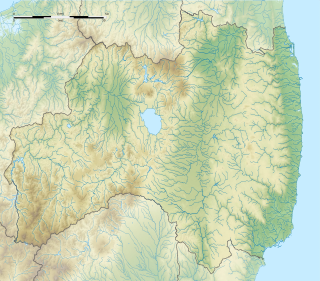 W
WNegishi Kanga ruins is an archaeological site with the ruins of a Heian period local government administrative complex and Buddhist temple, built over a Jōmon period settlement, located in what is now part of the city of Iwaki, Fukushima prefecture in the southern Tōhoku region of northern Honshu, Japan. It has been protected by the central government as a National Historic Site since 2005.
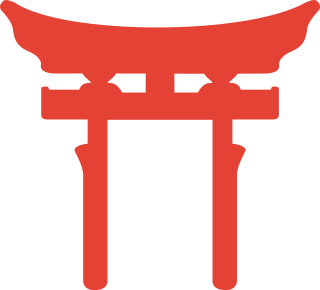 W
WThe Nihon Shoki (日本書紀), sometimes translated as The Chronicles of Japan, is the second-oldest book of classical Japanese history. The book is also called the Nihongi . It is more elaborate and detailed than the Kojiki, the oldest, and has proven to be an important tool for historians and archaeologists as it includes the most complete extant historical record of ancient Japan. The Nihon Shoki was finished in 720 under the editorial supervision of Prince Toneri and with the assistance of Ō no Yasumaro dedicated to Empress Genshō.
 W
WNoto Kokubun-ji (能登国分寺) was a Buddhist temple located in what is now the city of Nanao, Ishikawa, Japan. It was one of the provincial temples established by Emperor Shōmu during the Nara period for the purpose of promoting Buddhism as the national religion of Japan and standardising control of the Yamato rule to the provinces. The temple no longer exists, but the temple grounds were designated as a National Historic Site by the Japanese government in 1974.
 W
WThe Otomefudōhara Tile Kiln ruins is an archaeological site with the ruins of an early Nara period kiln, located in the city of Oyama, Tochigi Prefecture in the northern Kantō region of Japan. It was designated a National Historic Site of Japan in 1978.
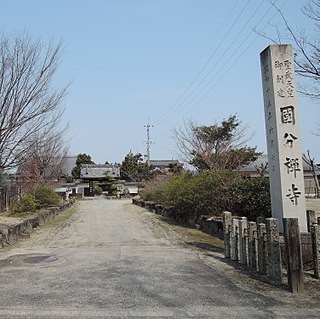 W
WThe Owari Kokubun-ji (尾張国分寺) is a Buddhist temple located in the city of Inazawa, Aichi, Japan. The temple belongs to the Myōshin-ji branch of the Rinzai school of Japanese Zen. Its main image is a statue of Yakushi Nyōrai. It is the modern successor of one of the provincial temples established by Emperor Shōmu during the Nara period for the purpose of promoting Buddhism as the national religion of Japan and standardising control of Yamato rule over the provinces. The foundation stones of the original temple was designated as a National Historic Site by the Japanese government in 2012.
 W
WThe Kōriyama ruins is an archaeological site with the ruins of a Nara period government office complex, temple and temple ruins located in what is now part of Taihaku-ku in the city of Sendai, Miyagi prefecture in the southern Tōhoku region of northern Honshu, Japan. It has been protected by the central government as a National Historic Site since 2006.
 W
WThe Shida Gunga ruins is an archaeological site containing the ruins of the Nara to early Heian period government administrative complex for Shiga District, Suruga Province, located in what is now part of the city of Fujieda, Shizuoka in the Tōkai region of Japan. The site was designated a National Historic Site of Japan in 1980.
 W
WShimotsuke Kokubun-ji (下野国分寺) is a Buddhist temple in the city of Shimotsuke, Tochigi, Japan, belonging to the Shingon-shu Buzan-ha sect, and is the provincial temple ("kokubunji") of former Shimotsuke Province. The present temple is of uncertain foundation, but claims to be the direct descendant of the original Nara period kokubunji temple which fell into ruins sometime in the Kamakura period. The Nara-period temple ruins were designated a National Historic Site in 1921, and the area under protection was expanded in 2005.
 W
WThe Shimotsuke Provincial Capital ruins is an archaeological site with the ruins of a Nara to Heian period government administrative complex located in what is now part of the city of Tochigi, Tochigi prefecture in the northern Kantō region of Japan. Identified as the ruins of the kokufu of Shimotsuke Province, the site is protected by the national government as a National Historic Site from 1982.
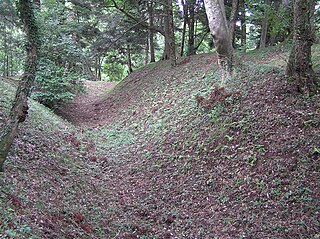 W
WThe Shirakawa Barrier is the location of a frontier fortification on the Ōshū Kaidō highway in what is now the Hatajuku neighborhood of the city of Shirakawa, Fukushima Japan, three kilometers south of the border of Tochigi PrefectureThe site was designated a National Historic Site in 1966., and is part of the Shirakawa Seki-no-mori Park, containing a reconstructed ancient house and preserved old farm houses.
 W
WThe Shirakawa Kanga ruins is a group of archaeological sites containing the ruins of the Nara to early Heian period government administrative complex for ancient Shirakawa District of Mutsu Province. It is located in what is now part of the village of Izumizaki, Fukushima in the Tōhoku region of Japan. The site was designated a National Historic Site of Japan in 1984. The designation includes the ruins of the Sekiwaku Kanga ruins (関和久官衙遺跡) and the nearby Kariyado temple ruins (借宿廃寺跡)
 W
WTaga Castle was a jōsaku-style Japanese castle built in the late Nara period in what is now part of the city of Tagajō in Miyagi prefecture in the Tōhoku region of far northern Honshu, Japan. Bashō tells of his visit to the site in Oku no Hosomichi. The ruins of Taga-jō and its former temple have been designated a Special Historic Site (特別史跡) since 1922.
 W
WSue pottery was a blue-gray form of high-fired pottery which was produced in Japan and southern Korea during the Kofun, Nara, and Heian periods of Japanese history. It was initially used for funerary and ritual objects, and originated from Korea to Kyūshū. Although the roots of Sueki reach back to ancient China, its direct precursor is the grayware of the Three Kingdoms of Korea.
 W
WThe Tago Stele is an Nara period stele discovered in the city of Takasaki, Gunma Prefecture, in the northern Kantō region of Japan. The stele was designated a National Historic Site of Japan in 1921, and was raised in status to that of a Special National Historic Site in 1954.As one of the "Three Stelae of Kōzuke", it was submitted by Japan for inclusion into the UNESCO Memory of the World Programme in 2017
 W
WTōdai-ji is a Buddhist temple complex that was once one of the powerful Seven Great Temples, located in the city of Nara, Japan. Though it was originally founded in the year 738 CE, Todai-ji was not opened until the year 752 CE. Its Great Buddha Hall houses the world's largest bronze statue of the Buddha Vairocana, known in Japanese as Daibutsu (大仏). The temple also serves as the Japanese headquarters of the Kegon school of Buddhism. The temple is a listed UNESCO World Heritage Site as one of the "Historic Monuments of Ancient Nara", together with seven other sites including temples, shrines and places in the city of Nara.
 W
WTōtōmi Kokubun-ji (遠江国分寺) was a Buddhist temple located in the Mitsuke neighborhood of what is now the city of Iwata, Shizuoka, Japan. It was one of the provincial temples established by Emperor Shōmu during the Nara period for the purpose of promoting Buddhism as the national religion of Japan and standardising control of the Yamato rule over the provinces. The original temple no longer exists, but the temple grounds are an archaeological site which was designated as a Special National Historic Site by the Japanese government in 1962.
 W
WWakasa Kokubun-ji (若狭国分寺) is a Sōtō Zen Buddhist temple in Obama, Fukui, Japan. It is one of the few surviving provincial temples established by Emperor Shōmu during the Nara period. Due to this connection, the temple grounds were designated as a National Historic Site by the Japanese government in 1976.
 W
WThe Yokodaidō Steel Production Site is an archaeological site in the city of Minamisōma, Fukushima Prefecture, in the southern Tōhoku region of northern Japan containing the ruins of a large-scale a late-Nara period to early Heian period bloomery (ironworks). The site was designated a National Historic Site of Japan in 2011 by the Japanese government.